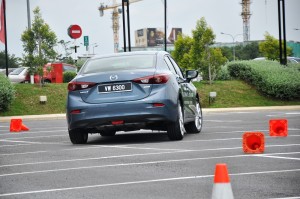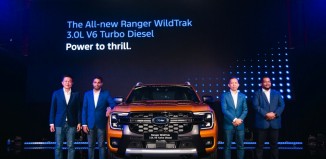Mazda 3, Mazda 6 & Mazda CX-3 Get G-Vectoring Control In Malaysia
Malaysia gets the Mazda 3, Mazda 6 and Mazda CX-3 updated with G-Vectoring Control (GVC). We will get to the GVC bit later but first, a little about the vehicles, which can be considered facelifts ranging from mild to not-so-mild.
The most change is seen in the Mazda 3 which gets a revised front bumper profile, front grille, fog lights, LED headlights and air intake. Likewise, the rear bumper has also been redesigned and a rear fog light has been included with the sedan’s bumper.
In the cabin, the most notable improvements are better noise insulation, a new steering wheel and neater, more luxurious center console with cup holders and an electronic parking brake. The head-up display (available only in the hatchback and top-spec sedan) has also been improved with color displays of navigation, speed and other data.
Power-wise, the 3 retains the same 2-liter SkyActiv-G engine and 6-speed SkyActiv-Drive automatic transmission with maximum output of 162 hp and 210 Nm. Color options are Arctic White, Blue Reflex, Meteor Grey and Aluminium Metallic.
The Mazda 3 is locally assembled in Kulim and priced at RM 113k (GL Sedan), RM 129k (High Spec Sedan) & RM 132k (Hatchback), with 5 years’ (or 100,000 km) warranty and 3 years’ (or 60,000 km) free maintenance (including labor, parts & lubricants).
Incidentally, Bermaz Motor, the sole distributor of Mazda in Malaysia, revealed that a new paint center in Kulim costing US$ 20 million, will be able to apply Mazda’s 4-layer painting process to the locally assembled models.
 The other models with GVC are the Mazda CX-3 and Mazda 6 (both are fully imported). The CX-3 received slight enhancements like exterior side door garnishing and 2 new colors i.e. Eternal Blue Mica and Machine Grey Metallic (in addition to the existing 7 colors – Soul Red Metallic, Ceramic Metallic, Deep Crystal Blue, Snowflake White Pearl Mica, Eternal Blue Mica, Machine Grey and Jet Black). The CX-3 is priced at RM 138k on the road with insurance (same warranty package as the Mazda 3 applies).
The other models with GVC are the Mazda CX-3 and Mazda 6 (both are fully imported). The CX-3 received slight enhancements like exterior side door garnishing and 2 new colors i.e. Eternal Blue Mica and Machine Grey Metallic (in addition to the existing 7 colors – Soul Red Metallic, Ceramic Metallic, Deep Crystal Blue, Snowflake White Pearl Mica, Eternal Blue Mica, Machine Grey and Jet Black). The CX-3 is priced at RM 138k on the road with insurance (same warranty package as the Mazda 3 applies).
 Meanwhile, the Mazda 6 with GVC is available in SkyActiv-G (2-liter petrol: 153 hp, 200 Nm; 2.5-liter: 185 hp, 250 Nm) and SkyActiv-D (2.2-liter diesel: 173 hp, 420 Nm). The 6 too receive just mild enhancements, like the exterior side turn lights and a new steering wheel and improved head-up display and multi-info display (MID).
Meanwhile, the Mazda 6 with GVC is available in SkyActiv-G (2-liter petrol: 153 hp, 200 Nm; 2.5-liter: 185 hp, 250 Nm) and SkyActiv-D (2.2-liter diesel: 173 hp, 420 Nm). The 6 too receive just mild enhancements, like the exterior side turn lights and a new steering wheel and improved head-up display and multi-info display (MID).
The petrol versions are available in sedan and touring forms while the diesel, only sedan. The petrol variants get 7 colors – Soul Red Metallic, Snowflake White Pearl, Meteor Grey, Sonic Silver Metallic, Jet Black, Machine Grey and Deep Crystal Blue. The diesel version however, settles with 4 colors – Soul Red Metallic, Snowflake White Pearl, Meteor Grey and Sonic Silver Metallic.
Prices are: 2-liter SkyActiv-G Sedan (RM 170k), 2.5-liter SkyActiv-G Sedan (RM 207k), 2.5-liter SkyActiv-G Touring (RM 211k) and 2.2-liter SkyActiv-D Sedan (RM 215k); same warranty package applies.
Bermaz Motor is holding a “Let’s Celebrate Driving” event at the Setia City Convention Centre from today until 1 May. There will be cars with and without GVC for you to try out on a circuit. At the same time, there is a Mazda roadshow within Setia City Mall, also ending on 1 May.
What Is G-Vectoring Control?
G-Vectoring Control or GVC is simply, a software designed to be a part of the SkyActiv suite of technologies which cover engine, transmission, body and chassis. It essentially controls the engine torque based on steering movement and acceleration, to provide for improved handling and ride quality to the vehicle occupants (especially the passengers) not just around corners but on straight roads.
 When cornering, the GVC system will adjust engine torque and shift the vehicle’s weight to the tires which need more traction. While the power or torque aspect is hardly felt by driver or passenger(s), what is apparent is the reduced movement of the human body as the car goes through a corner. There is still some body roll but it will not be as pronounced as a car without GVC.
When cornering, the GVC system will adjust engine torque and shift the vehicle’s weight to the tires which need more traction. While the power or torque aspect is hardly felt by driver or passenger(s), what is apparent is the reduced movement of the human body as the car goes through a corner. There is still some body roll but it will not be as pronounced as a car without GVC.
Similarly, the system works to reduce constant minor steering corrections on a straight road, resulting in the driving feeling less fatigue after a long drive. The videos below illustrate how this system works.
































